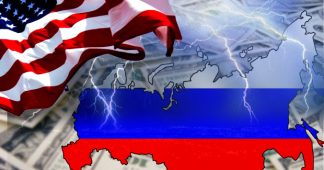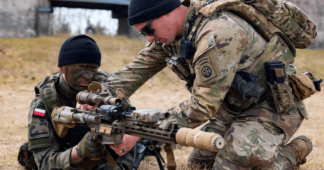The Biden doctrine is a cynical effort to cash in on the blood of another nation.
By Peter Van Buren *
Joe Biden created for the U.S. a war like no other, one where others die and the U.S. simply sits back and pays the bills on a gargantuan scale. No attempts are made at diplomacy by the Americans, and the diplomatic efforts of others like the Chinese are dismissed as evil attempts to gain influence in the area (similar to the dismissal of Chinese diplomatic work in the Yemen war.) Biden is coming close to achieving 1984’s end state of perpetual warfare, while only putting a handful of American lives at risk. He has learned lessons from the Cold War, and has already put them into play. Can we call it the Biden Doctrine yet?
Biden’s strategy is clear enough now after well more than a year of conflict; what he has been sending to Ukraine jumped from helmets and uniforms to F-16s in only fifteen months and shows no signs of stopping. The problem is U.S. weapons are never enough for victory and are always “just enough” to allow the battle to go on until the next round. If the Ukrainians think they are playing the U.S. for arms, they best check who is really paying for everything in blood.
Putin is playing this game himself in a way, careful not to introduce anything too powerful, such as strategic bombers, and upset the balance and offer Biden the chance to intervene in the war directly: One can hear old man Joe Biden on TV now, explaining American airstrikes are needed to prevent a genocide, the go-to excuse he learned at Obama’s knee. Ukraine will learn even with the promise of the F-16 it can’t acquire aircraft and train up pilots fast enough (minimum training time is 18-24 months), and next will be begging the U.S. to serve as its air force. That’s what the current escalation portends: air power.
As it is, the planes are likely to be based out of Poland and Romania, suggesting NATO will pick up the high-skilled tasks (and costs) of maintaining and repairing them. Left unclear is the NATO role in required aerial refueling to keep the planes lingering over the battlefield. F-16s aside, a spin off bonus to all these weapons gifts is that the vast majority of transfers to date have been “presidential drawdowns.” This means the U.S. sends used or older weapons to Ukraine, after which the Pentagon can use the Congressionally authorized funds to replenish their stocks by purchasing new arms. The irony that war machines once in Iraq under President Obama are now recycled on the ground in Ukraine under his former vice president can’t be missed.
The U.S. strategy seems based on creating a ghastly tie of sorts, two sides lined up across a field shooting at each other until one side calls it quits for the day. The same strategy was in play in 1865 and 1914, but the new factor is today those armies face off across those fields with 21st century HIMARS artillery, machine guns, and other tools of killing far more effective than a musket or even a Gatling gun. It is unsustainable, literally chewing up men—albeit not Americans. The question of how many more Ukrainians have to die is answered privately by Biden as ‘potentially all of them.’ Anything else requires you to cynically believe Biden thinks he can simply purchase victory.
Up until now this has all been the Cold War playbook. Fighting to the last Afghan was a strategy perfected in Soviet-held Afghanistan in the 1980s. What is different now is the scale—since Russia invaded Ukraine, the United States has sent over $40 billion worth of military aid to support Kiev’s war effort, the single largest arms transfer in U.S. history and one with no signs of stopping. A single F-16 costs up to $350 million a copy if bought with weapons, maintenance equipment, and spare parts kits.
Yet despite the similarities to Cold War Strategy 101, some lessons have been learned over the intervening years. One of America’s failures throughout the Cold War and the War on Terror was the use of puppet governments largely imposed or kept on life support by American money and muscle. Because these governments lacked the support of the people (see Vietnam, Iraq, and Afghanistan), they were non-starters with the lifespan of fruit flies. Ukraine is different; the puppet government is the government, beholden to the U.S. for its very survival but more or less supported directly by the people for now.
The other lesson learned has to do with nation-building, or rebuilding, or reconstruction—whatever the vast postwar expenditures will be called in this conflict. No more straight-up governmental efforts as in Vietnam, Iraq, and Afghanistan. This time it will be all private enterprise. “It is obvious that American business can become the locomotive that will once again push forward global economic growth,” President Zelensky said, boasting BlackRock, JP Morgan, and Goldman Sachs. Others, he said, “have already become part of our Ukrainian way.”
The Ukrainian chamber of commerce called the country “the world’s largest construction site.” The New York Times echoed one prediction that claimed rebuilding efforts will cost $750 billion. Ukraine reconstruction will be, says the Times, a “gold rush…. Russia is stepping up its offensive heading into the second year of the war, but already the staggering rebuilding task is evident. Hundreds of thousands of homes, schools, hospitals and factories have been obliterated along with critical energy facilities and miles of roads, rail tracks and seaports. The profound human tragedy is unavoidably also a huge economic opportunity.” Earlier this year JP Morgan and Zelensky signed a memorandum of understanding stipulating Morgan would assist Ukraine in its reconstruction.
And maybe those large American companies have learned the lessons of Iraq and Afghanistan. Of the billions spent, much money was wasted on dead ends and much was siphoned off due to corruption. But success or failure, the contractors always got paid in our Wars of Terror. With that in mind, more than 300 companies from 22 countries signed up for a Rebuild Ukraine exhibition and conference in Warsaw. At the World Economic Forum in Switzerland, a standing-room-only crowd packed a conference called Ukraine House Davos to discuss investment opportunities.
The eventual gold rush in rebuilding makes for an interesting addendum to the Biden strategy of fighting to the last Ukrainian. The more that is destroyed the more that needs to be rebuilt, which offers more money for U.S. companies smart enough to wait by the trough for the killing to subside. But why wait? Drones operated by Danish companies have already mapped every bombed-out structure in the Mykolaiv region, with an eye toward using the data to help decide which reconstruction contracts should be issued.
So let’s put some lipstick on this pig of a strategy and call it the Biden Doctrine. Part I is to limit direct U.S. combat involvement while fanning the flames for others. Part II is to provide massive amounts of arms to enable a fight to the last local person. Part III is to transform the home government into a puppet instead of creating an unpopular one afresh. Part IV is to turn the reconstruction process into a profit center for American companies. How long the war lasts and how many die are not part of the strategy.
The off-ramp in Ukraine, a diplomatic outcome that resets the map to pre-invasion 2022 levels, is clear enough to Washington. The Biden administration seems shamelessly content not to call for diplomatic efforts, but instead to bleed out the Russians as if this were Afghanistan 1980, albeit in the heart of Europe.
* Peter Van Buren is the author of We Meant Well: How I Helped Lose the Battle for the Hearts and Minds of the Iraqi People, Hooper’s War: A Novel of WWII Japan, and Ghosts of Tom Joad: A Story of the 99 Percent.
We remind our readers that publication of articles on our site does not mean that we agree with what is written. Our policy is to publish anything which we consider of interest, so as to assist our readers in forming their opinions. Sometimes we even publish articles with which we totally disagree, since we believe it is important for our readers to be informed on as wide a spectrum of views as possible.










